Like their woodwind counterparts, brass instruments belong to the wind instrument category. The most recognized members include the trumpet, cornet, flugelhorn, trombone, tuba, euphonium, baritone horn, alto (tenor) horn, and French horn. While sharing some similarities with woodwinds, brass instruments possess distinct characteristics. This guide offers an in-depth exploration of the Brass Family Instruments.
Construction and Sound Production: Key Differences
While woodwind instruments can be crafted from diverse materials—not limited to wood, as the name might suggest, but also metals like silver or gold—brass instruments are primarily constructed from brass tubing. This tubing varies in diameter and shape and features a detachable mouthpiece at one end and a flared bell at the opposite end. Certain models may feature silver or gold plating.
The method of sound production also distinguishes brass from woodwind instruments. A woodwind player generates sound by blowing directly into a headjoint, mouthpiece, or reed, creating a column of air within the instrument that vibrates to produce sound. In contrast, brass players produce sound by vibrating, or “buzzing,” their lips against the mouthpiece. Skilled brass players can achieve the full range of their instruments by skillfully adjusting their lip vibrations, a technique known as embouchure.
Pitch alteration also differs between these instrument families. Woodwind instruments typically change pitch by the player covering and uncovering holes along the instrument’s body. Brass instruments, however, utilize valves (in addition to embouchure manipulation) to modify pitch. Activating a valve directs air into supplementary tubing, effectively lengthening the instrument’s overall tube length and consequently lowering the pitch. Valves essentially modify the internal length of the instrument, changing the distance air travels and expanding the range of playable notes. The introduction of valves greatly simplified pitch changes, enabling the performance of a wide array of notes. With the exception of the slide trombone, which uses a sliding tube to manually adjust tube length, all brass instruments employ valves.
Brass instruments utilize two primary valve types: piston valves and rotary valves. Piston valves operate vertically; pressing down opens the valve, and releasing closes it. Rotary valves achieve the same outcome through a different mechanism. Instead of a vertical press, a lever is pressed, rotating a circular rotor to open air channels into additional tubing. Piston valves are generally considered more precise, while rotary valves are known for their smoother action.
The Trumpet, Cornet, and Flugelhorn Family
The trumpet boasts a rich history, evolving significantly from its ancient predecessors crafted from seashells, animal horns, ivory, and even human bones. Archaeological discoveries reveal that metal trumpets, made of silver or bronze, were used in ancient Egypt as early as 1500 BC. The ancient Greeks and Romans later adopted similar instruments.
In these early periods, trumpets served primarily for military signaling and religious ceremonies, functioning similarly to a bugle, where pitch variation relies solely on the player’s embouchure. The pivotal addition of valves to the trumpet occurred in the 18th century. This innovation revolutionized the instrument, enabling musicians to play all notes within a chromatic scale across multiple octaves.
This expanded melodic capability transformed the trumpet into a prominent instrument in classical music and subsequently in jazz orchestras and ensembles. The expressiveness and musicality of the trumpet are evident in the recordings of masters like Miles Davis, Dizzy Gillespie, and Louis Armstrong.
Most contemporary trumpets feature three valves. Depressing the first valve lowers the pitch by a whole step, the second by a half step, and the third by one and a half steps. By employing various valve combinations, including “half-valving” (partially depressing a valve), players can access a wide range of notes.
Yamaha YTR-9335CHS B♭ trumpet. The most prevalent modern trumpet is the B♭ trumpet, offering a range from Concert F# to D two octaves higher. However, other variations exist, including the C trumpet, the piccolo trumpet (smaller and higher-pitched), and the bass trumpet (larger and lower-pitched).
The cornet shares similarities with the trumpet but features a more conical bore (internal chamber), resulting in a warmer, mellower tone compared to the brighter sound of a trumpet. Its smaller size and ease of handling make it a popular choice for beginning students. Despite this, cornets are also favored by advanced and professional musicians, especially in military-style brass bands, due to their distinctive tone. The B♭ cornet is the most common model, possessing the same fingerings and range as a B♭ trumpet. The E♭ soprano cornet, pitched higher, is less common.
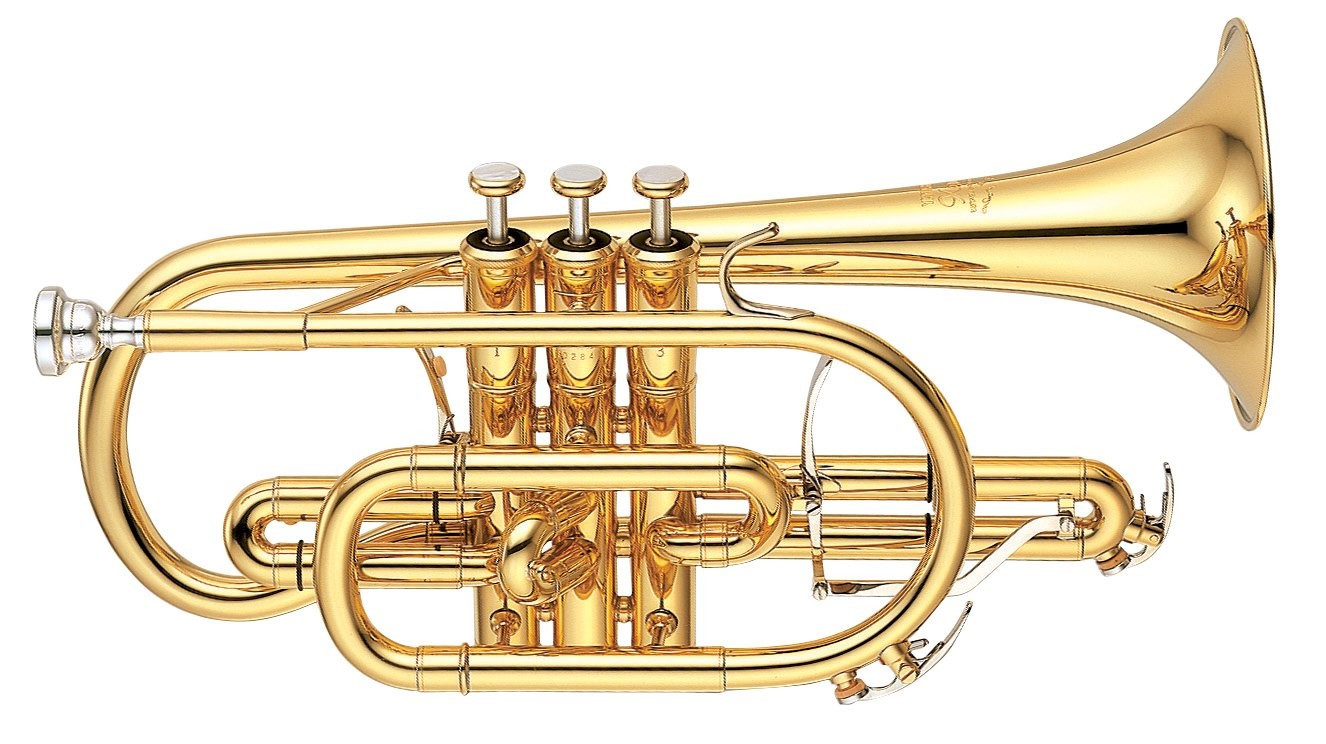 Gold horn. Yamaha YCR-8335 cornet. Another variation is the flugelhorn, which resembles a trumpet in design but has an even more conical bore than the cornet, producing an even mellower tone. Its name originates from the German word “flugel,” meaning “wing,” describing the instrument’s shape. Similar to trumpets and cornets, most flugelhorns are pitched in B♭, though C models are also available. Flugelhorns find use in jazz, brass bands, marching bands, and orchestras.
Gold horn. Yamaha YCR-8335 cornet. Another variation is the flugelhorn, which resembles a trumpet in design but has an even more conical bore than the cornet, producing an even mellower tone. Its name originates from the German word “flugel,” meaning “wing,” describing the instrument’s shape. Similar to trumpets and cornets, most flugelhorns are pitched in B♭, though C models are also available. Flugelhorns find use in jazz, brass bands, marching bands, and orchestras.
Yamaha YFH-631G flugelhorn.
The Trombone Family
The trombone’s earliest documented use, initially known as a “sackbut,” dates back to 15th-century religious music. By the 18th century, its popularity had grown, leading to its integration into classical and popular music. Today, trombones are widely used as section and solo instruments across jazz, pop, and classical ensembles.
Trombone mouthpieces are available in various sizes. Smaller mouthpieces produce a brighter sound and facilitate playing higher notes.
The slide trombone, the most prevalent type, features a telescoping section of tubing called a “slide.” Musicians move this slide forward and backward to lengthen or shorten the total tube length, thereby altering the pitch. The slide enables trombonists to smoothly glide between notes, creating a legato phrasing unique among brass instruments.
Tenor trombones constitute the majority of trombones in use, with a range spanning from Concert E to F three octaves higher.
 Gold and silver horn. Yamaha YSL-610 tenor trombone. Other trombone varieties include the bass trombone and the alto trombone.
Gold and silver horn. Yamaha YSL-610 tenor trombone. Other trombone varieties include the bass trombone and the alto trombone.
Yamaha YBL-835 bass trombone.  Gold horn. Yamaha YSL-872 alto trombone. Valve trombones, a less common type, utilize three or four piston valves for pitch changes instead of a slide. While somewhat easier for trumpet players to learn and facilitating faster passages, they possess a slightly less “open” tone than traditional slide trombones.
Gold horn. Yamaha YSL-872 alto trombone. Valve trombones, a less common type, utilize three or four piston valves for pitch changes instead of a slide. While somewhat easier for trumpet players to learn and facilitating faster passages, they possess a slightly less “open” tone than traditional slide trombones.
Yamaha YSL-354V valve trombone.
Tuba, Sousaphone, Euphonium, Baritone Horn, and Alto (Tenor) Horn: The Lower Brass
The tuba, invented in 1835 and named after the Latin word for “tube,” is a relatively recent addition to the brass family instruments. It is the largest and lowest-pitched member of the brass family.
If straightened, the tubing of a B♭ tuba—the most common variation—would measure approximately 18 feet long. Contributing to its low-note capability, the tuba has the widest bore among brass instruments.
Due to their low range, tubas are used for bass lines in orchestras, marching bands, and various brass ensembles. They are also commonly employed in place of string basses in traditional New Orleans jazz and ragtime bands.
Like trumpets, tubas utilize valves to extend tube length for pitch alteration. However, the number of valves varies, with tubas having three to six valves; the valve count impacts range and intonation.
Three-valve tubas are generally used by beginners due to their simpler learning curve. Advanced tuba players typically use instruments with four or more valves, as at least four valves are necessary to play all notes within a tuba’s standard range.
The tuba family encompasses several variations. The C tuba, slightly higher-pitched (with two feet less tubing) than the B♭ tuba, is favored by orchestral tubists for its clearer tone. Other variations include the E♭ tuba, F tuba, and the baritone tuba.
Yamaha YCB-623 C tuba.
Yamaha YBB-641 B♭ tuba.
The sousaphone, designed by composer and conductor John Philip Sousa in 1890 for marching bands, is a related instrument. Its body wraps around the player and is lighter than a standard tuba. It typically has three valves, resulting in a higher lowest note compared to a four-valve B♭ tuba.
Other related instruments include the euphonium, the baritone horn, and the alto horn (sometimes referred to as “tenor” horn). The euphonium resembles a tuba but has a range an octave higher than a B♭ tuba. Euphoniums are commonly found in concert bands and can also be used as solo instruments. The baritone horn, pitched in B♭, shares the same tonal range as the euphonium. Consequently, many euphonium players also play the baritone horn, and vice versa.
Yamaha YEP-321S euphonium. Compared to a euphonium, the baritone horn has a brighter timbre and a thinner bore. A euphonium with a forward-facing bell and pistons is sometimes called a baritone to distinguish it from a true euphonium.
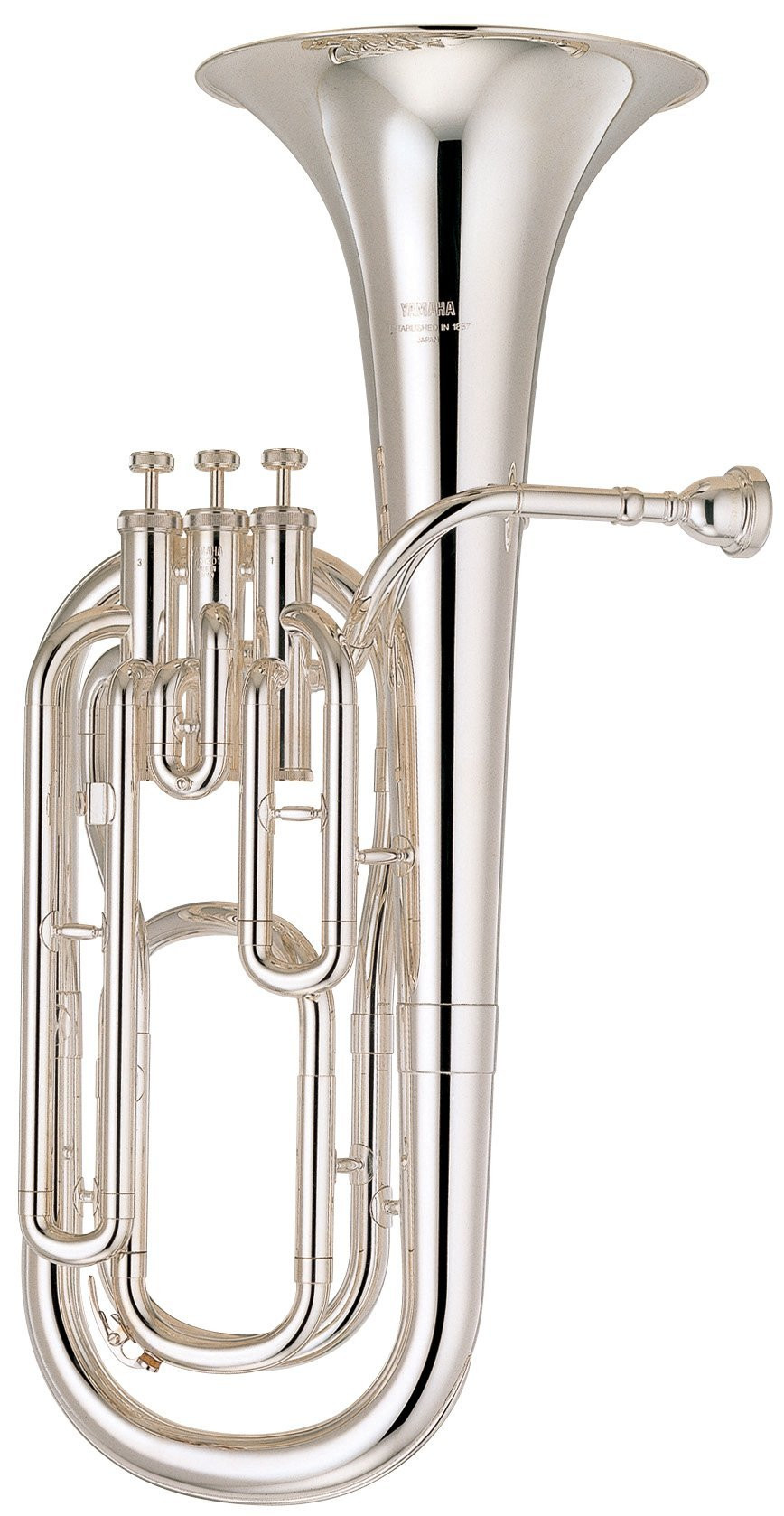 Silver horn. Yamaha YBH-301S baritone horn. The alto (tenor) horn is pitched in E♭, five tones lower than a trumpet, and is sometimes played by trumpet players. It is visually similar to a euphonium and primarily used in brass and marching bands.
Silver horn. Yamaha YBH-301S baritone horn. The alto (tenor) horn is pitched in E♭, five tones lower than a trumpet, and is sometimes played by trumpet players. It is visually similar to a euphonium and primarily used in brass and marching bands.
Yamaha YAH-803S alto horn.
The Unique French Horn
Despite its name, the French horn originated in Germany in the mid-1800s. The contemporary French horn possesses a distinctive, mellow, and highly expressive tone. It excels as both a solo instrument and within an orchestral horn section; orchestras typically include four French horns.
Uniquely among brass instruments, the French horn requires the player to place one hand inside the bell while playing. This technique, known as hand-stopping, allows for manual adjustment of the tube length, altering the pitch by a semitone or whole tone. While originating before valve invention and thus no longer strictly necessary for pitch change, hand-stopping remains a crucial aspect of French horn technique.
French horns come in four main types. The single horn, featuring three rotary valves, is mainly used by beginners and comes in F horn and B♭ horn varieties.
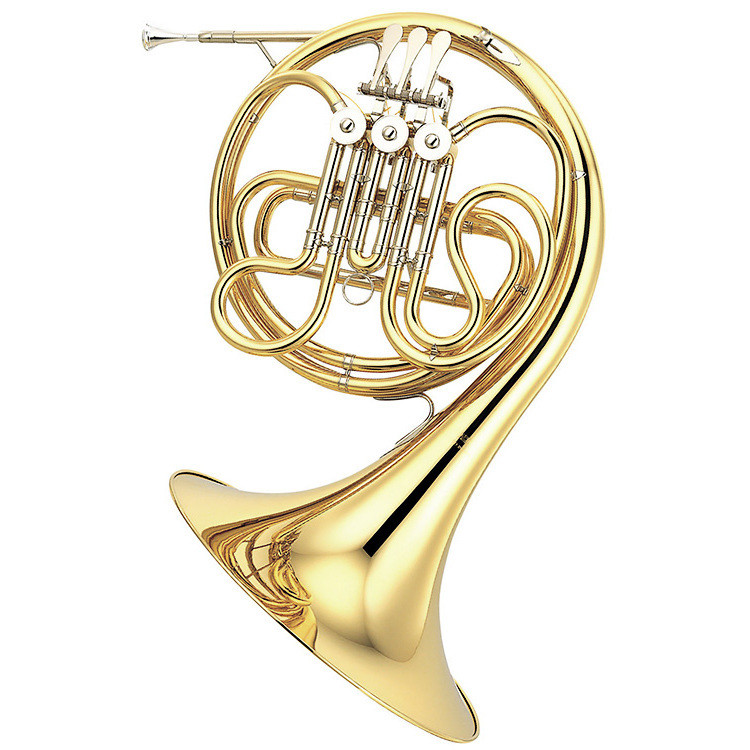 Gold and silver horn. Yamaha YHR-314II F single French horn. The F French horn contains more tubing and is pitched lower than the B♭ horn. The B♭ horn is easier to play, but the F horn offers a wider range of notes and a purer tone.
Gold and silver horn. Yamaha YHR-314II F single French horn. The F French horn contains more tubing and is pitched lower than the B♭ horn. The B♭ horn is easier to play, but the F horn offers a wider range of notes and a purer tone.
Double horns, commonly used by advanced players, incorporate a second complete tube section, effectively combining a B♭ and F horn into one instrument. This expands the available note range; a fourth valve switches between the two sections.
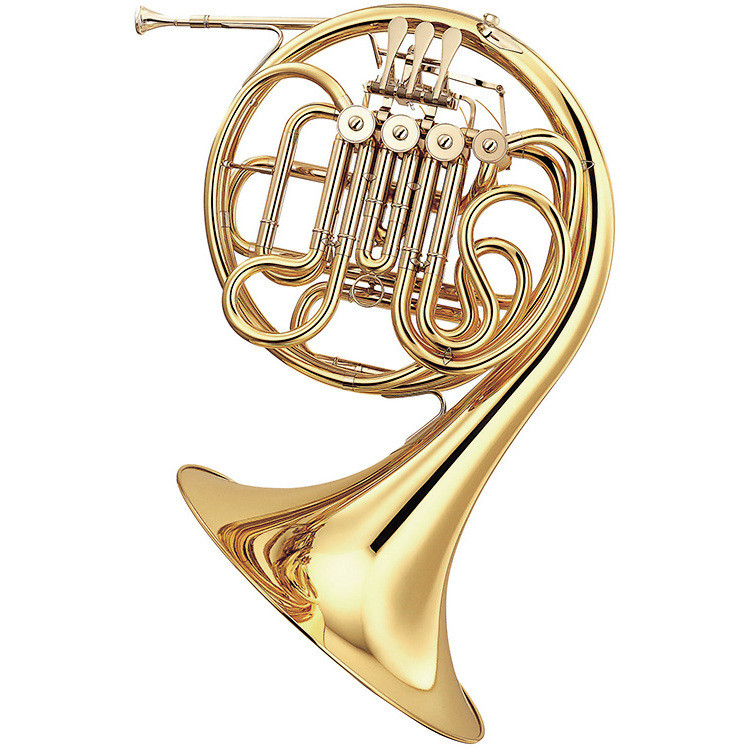 Gold and silver horn. Yamaha YHR-567 double French horn. The descant double horn variation features a B♭ and a high-F section, with the high-F section sounding an octave higher than the regular F section.
Gold and silver horn. Yamaha YHR-567 double French horn. The descant double horn variation features a B♭ and a high-F section, with the high-F section sounding an octave higher than the regular F section.
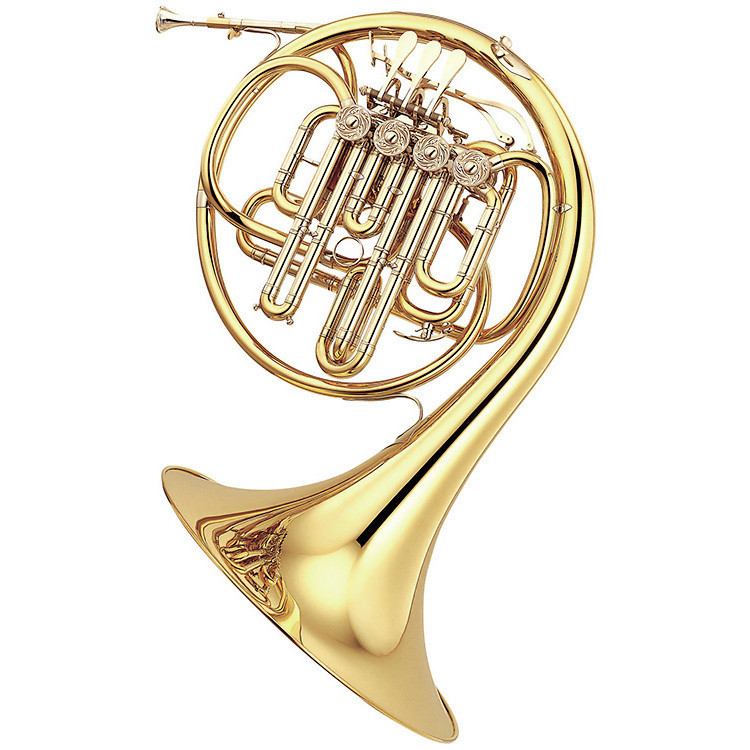 Gold horn. Yamaha YHR-881 descant double French horn. The triple horn represents perhaps the most advanced French horn type.
Gold horn. Yamaha YHR-881 descant double French horn. The triple horn represents perhaps the most advanced French horn type.
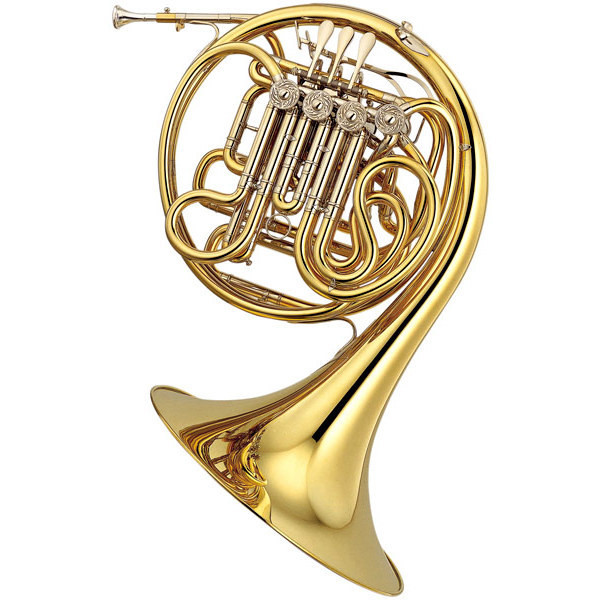 Gold and silver horn. Yamaha YHR-891 triple French horn. This is essentially a full double horn that also includes a high-F horn for playing in higher registers. While the overall pitch range remains technically the same, the high-F side provides greater stability in the upper range.
Gold and silver horn. Yamaha YHR-891 triple French horn. This is essentially a full double horn that also includes a high-F horn for playing in higher registers. While the overall pitch range remains technically the same, the high-F side provides greater stability in the upper range.
Explore further into Yamaha trumpets, cornets, flugelhorns, trombones, tubas, euphoniums, baritone horns, alto (tenor) horns, and French horns.

